Only feeble signs of manufacturing returning to the US (you’ve got to build the plants first).
Construction spending, an important part of the US economy, has essentially gone nowhere over the past 18 months – the longest period of drought since the great recession. Total construction spending – residential and nonresidential, private and public – in June fell 2.1% from June last year to a seasonally adjusted annual rate of $1.29 trillion, according to the Commerce Department today.
Construction spending has now fallen on a year-over-year basis in four of the last five months, and is back where it had first been in January 2018:
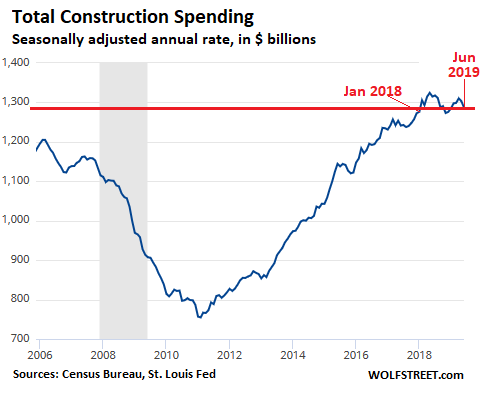
All figures are quoted as “annual rate.” Annual rate means that at the June pace, construction spending for the whole year would total $1.29 trillion.
Residential construction spending – 99% is “private” rather than “public” spending – dropped 8% from June 2018, the ninth month in a row of year-over-year declines, to a seasonally adjusted annual rate of $513 billion, back to January and February 2017 levels, and down 10% from the recent peak in April 2018. Note, that residential construction spending never fully recovered from the collapse during the Housing Bust:
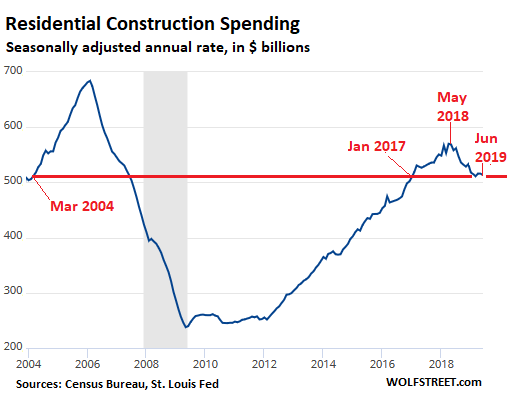
The decline in residential construction spending has been the dominant culprit for weak overall construction spending since mid-2018. But residential construction has stabilized near the $513 billion level during the past five months, and has stopped dropping. Now nonresidential construction spending is getting weak.
Nonresidential construction spending – which is about 50% larger than residential construction spending and is therefore a lot more important for the economy – had been growing at a decent clip through April, when it peaked at a seasonally adjusted annual rate of $794 billion, a historic record. But over the past two months, spending has dropped on a month-to-month basis, to a rate of $773 billion in June. This reduced the year-over-year gain to just 2.3%:
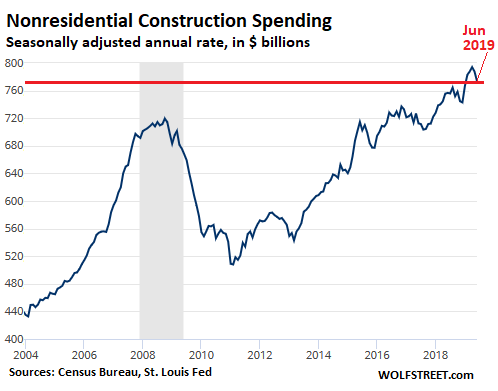
Unlike residential construction, nonresidential construction – which also collapsed during the Great Recession – has blown past the 2008 peak. But it took 8 years!
As the above chart shows, so far, the month-to-month declines still look fairly benign compared to episodes of declines in 2013, 2015, 2017, and even the four-month dip in 2018. So, it’s not yet time to panic. But the thing is, residential construction is weak, and if nonresidential construction continues to fall, overall construction spending is going to sag in a much more pronounced way.
Private spending on nonresidential construction in June ticked down 0.4% year over year to a rate of $456 billion.
Public spending on nonresidential construction – by federal, state, and local governments for bridges, sewer projects, administrative buildings, etc. – declined on a month to month bases for the second month in a row, to a rate of $318 billion, down from the record spike in April. So year-over-year, given the double-digit growth earlier this year – it was still up 6.4%.
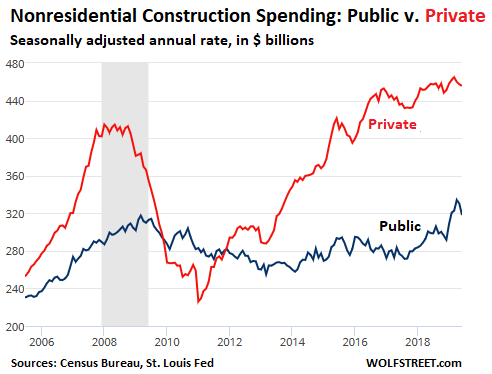
Of the largest segments of private nonresidential construction spending, the top two had sharp year-over-year declines in June; the remaining four booked sharp increases:
- Power, highly volatile but roughly flat since 2012: -4.8% yoy, to $92.4 billion.
- Commercial: -12.0% yoy, to $78.7 billion.
- Manufacturing (more in a moment): +10% yoy, to $71 billion.
- Office, at all-time record levels: +8.9% yoy, to $68.2 billion.
- Lodging: +8.1% yoy, to $33 billion.
- Healthcare: +5.9% yoy, to $34 billion.
Since “bringing manufacturing back to the US” is currently such a politically charged topic, a special word about construction spending on manufacturing facilities, because you’ve got to build the plants first: It’s up 10% year-over-year, but…. Construction spending peaked in June 2015 at a historic record, and has since fallen 15% despite the increases in recent months. In terms of hopes that there would be a boom in US manufacturing – which would be coming along with a boom in spending on manufacturing facilities – the jury is still out.
Growth in manufacturing production – what is actually being produced at these plants – is languid at the moment, to put a positive spin on it. And the uptick in construction spending for manufacturing facilities since May 2018 is not in the same ballpark as the surge in early 2015, but it’s mildly encouraging:
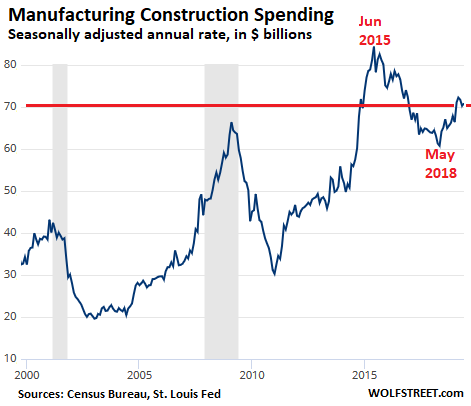
Consumers and companies keep plugging, the world has not come to an end. Read... World Trade in Face of Tariffmageddon, Trade Wars & Manufacturing Slowdown
Enjoy reading WOLF STREET and want to support it? You can donate. I appreciate it immensely. Click on the mug to find out how:
![]()


Must be that balance sheet run off.
The Balance Sheet Runoff reduced Fed Assets by about $658 billion (from the peak in April 2017). But little talked about is the reduction of Excess Reserves. Reserve Balance dropped by about $1.3 Trillion from July 2014.
From December 2018 alone reserves dropped by about $790 billion.
Talk about reduction of investment liquidity. Since the dealers needed to buy more and more Treasuries, they had to raise that money from I guess REPO. The lack for foreign money is really showing.
I’ve seen tons of non-residential construction in my area and it all sitting empty once built. They even modernized/uglified the Hoffman Agency building on 2nd street here and nope, no takers, all that money spent and it’s been sitting empty for years.
Once-occupied non-residential spaces are emptying out too. Safeway, Walgreens, as well as row upon row of small storefronts, all empty now. The Panera on Brokaw and Old Oakland Road – empty.
I see a lot of residential being built, which in a way is good news, because after the next crash you’ll be able to get a pretty nice place for $300 a month or so. Better have tele-work for some company in China…
$300/mo in San Jose?
Oh you mean San Jose, Costa Rica. Yeah I suppose you could get something for that.
Just for contrast, do you ever have time to bike up to look at the “Apple Spaceship” construction (maybe it’s done?), assuming there is an accessible bike route and overlook?
I imagine that, along with similar SV stuff count as factories, or is it just Musk’s stuff in Nev.
I haven’t followed up on it recently, but yeah, the “Apple Spaceship” or “Flying Saucer” since it’s round. It was laid out with no regard to existing traffic, residences, etc. Typical Apple style.
There are/were some neat drone videos by people who’d flown drones around it while it was under construction. It’s got to be finished by now. My impression was they want to have a work environment where the nerds never want to leave. I mean, Google etc have tried this but the nerds still escape going out for lunch etc., in Apple’s case they really want a fully contained environment with “green spaces” and I suppose babbling brooks with “H1B’s” smuggled in and being paid $2 an hour to scoop up the dead fish after-hours.
Great until that chip in your hand changes color, I guess.
Saw some drone shots. Also recall quite a bit of residential areas? The modern “Company Town”?
Visited Ex-wife’s relatives in Scotia years back, last classic company town? Rows of shacks surrounded by 1″ gravel. But they most all had their trophy bucks, elk, on wood panel wall, big 4WD p/u’s, dirt bikes, ATV’s, expensive (Remington 700) hunting rifles, and were quite happy. Whistle blew, they all walked back to mill after lunch. Early’70s.
Also was great till timber at coast ran out.
In any case, yeah, great until the timber runs out etc.
Hence my user name – Detroit used to be a bangin’ place once upon a time, until it wasn’t. I believe one of the best “actors” in the movie “The Blues Brothers” was the city and surroundings of Chicago, and one of the points of the film was how great a place it had once been.
The Architecture Billings Index (ABI) seems to say the pipeline may be drying up for nonresidential, but the backlog is still strong, of course whether some of the backlog gets cancelled, who knows?
“In addition, while inquiries into new work and the value of new design contracts remained positive in June, the pace of that growth continued to slow, with inquiries in particular falling to its lowest score in a decade. However, firms are still reporting strong backlogs of work in the pipeline, six and a half months on average, which continues to be the most robust that backlogs have been since we began collecting this data on a quarterly basis in 2010.”
https://www.aia.org/pages/6175201-abi-june-2019-architecture-firms-report-an
I just watched a video by WSJ saying that only about 5% of Chinese manufacturing that left came home to USA. Most who left went to Vietnam or Southeast Asia and there is a lot of transshipment happening.
South and Southeast Asia is a huge growing market. It’s the future.
More debt recycling, read savings glut:
https://www.bloomberg.com/news/articles/2019-08-01/how-savings-glut-still-sways-u-s-bonds-the-taiwan-connection
If you look at Germany (and to some extent France), they do not hold a huge US Treasury and Agency horde. Germany exports to US about the same as China but has only about $64Billion in UST while China has $1.067 Trillion.
Sorry I was wrong. China exports a lot more than Germany.
Exports: China 2.41T Germany 1.33T
Imports: China 1.54T Germany 1.08T
Therefore, China has a lot more net (exports minus imports) balance to buy dollar assets.
It is a mixed bag here in Thailand. Residential property sales are strong, boosted by the Chinese. Export growth is weak and prospects for the huge auto sector are reflective of the global situation. Tourism is weakening.
The fishing village on the west coast of the Gulf of Thailand that became my home 11 years ago is now a town, doubling in size in that time. However I am now seeing unsold property for the first time.
Wahtsb the US vacancy rate of industrial property suitable for heavy medium and tech “production”??
I ask as the US has an Established economy infrastructure base and has gone through a period of manufacturing loss, leading to Vacant manufacturing infrastructure.
No need to worry. Know why not?
**>> “tariffs out the wazoo” <<**
^ caption coming to a wolfstreet chart soon
From tranquility to volatility.
Sell your HK apt til Mon. before stormtroopers stomp HK freedom.
Trade talk with China, no way going back the ole way.
300B x 10% = BS.
Make a beeline for Vancouver! :)
From tranquility to volatility.
Inner cities sealed Pandora box was opened.
Nobody own it. Nobody can put it back. Nobody can control it.
Welcome back volatility.
Oilfield pipeline construction is up. Mall/retail construction spending – what is that?
Some trends toward telecommuting have been observed.
German yield curve fallen and can’t get up.
With over 50% of the S&P 500 reporting for Q2, EPS growth is negative. 2019 Q1 EPS growth was also negative.
Some businesses are not returning to the US, but are moving to SE Asia, India etc.
Trade wars are raging disrupting “free markets.”
Many new robotic manufacturing facilities, especially using renewable energy, will not be built in the US until the tariffs seem permanent. How would you like to start a multi-billion project and suddenly the tariffs are canceled? Tesla’s battery plant comes to mind.
What good is a robotic manufacturing facility? A town can’t exist on the jobs provided, because there aren’t any. The whole point of trying to attract manufacturing was to get the jobs that were required. With a robotic plant, the town gets the pollution from the plant, but no jobs.
There are plenty of people working in an automated plant, but they do other things than manufacturing laborers used to do. Go check out the automated auto manufacturing plants. They have thousands of often highly skilled workers, from assembly workers to those that maintain, install, and reprogram the robots. Plus the robots have to be designed and made, and that requires labor — hopefully in the US not China. And infrastructure and buildings have to be built and maintained. Manufacturing ads a lot of economic activity.
But you’re right in this sense: now 3,000 workers at an automated plant are producing more than 50,000 workers did at a plant without automation (which don’t exist anymore in the auto industry).
Guilty? I was one. 1985-2002. Hired as electro-mech, then in 2 years or so was elect tech at USPS. (thank the gods for vet 5 pts on test, saved me from homelessness)
Machinery we fixed didn’t look at all like “classic” robots, but they were, replaced several 100K jobs of clerks, carriers, and mailhandlers. Most all were built under lisc from AEG Telefunken (think learning tech acronyms are bad? Try ’em in German!) by Electrocom in Arlington TX. Instructor at tech school (84 weeks in Norman OK + teletraining and still not enough to keep up with rapid deployment, improvements) said his kid worked there…piecework. Of course not all of it was, but these machines had many similar modules, most full of repeating simple parts. Maybe 10% of machines from “US Corps”, if there is such a thing anymore.
PS: To all who despise gov’t workers, I have equal amount of time in private sector (up to 1000 people, just in one local site) and managers take care of their own in BOTH.
They’re building an automated factory that will only have 2 employees: an engineer and a dog that will bite the engineer if they try to “improve” anything. ? Engineer joke.
Isn’t this the place the US can compete with the rest of the world, robot labor? That means exporting goods, keeping industry innovation and secrets at home.
.The US has an advantage in-that game also Energy Security.
In ccp china you never know when the ccp will decide to turn out the lights on forigen manufacturing.
The interest rates are too damn high
The Rent# Is too Damn High!!
The DEBT is too Damn High
Creeping austerity is too damn high!
Yep. Debt is way too Damn high, and no one cares!
The Fed Funds Rate Drop had an immediate effect to the RATE in the Fed Funds Market (measured by the EFFR 2.14%) and the REPO Market (measured by SOFR 2.19%). I would think the Lender should hate this but the Borrower might like it. The real winner is the Treasury since it pays less for interest and coupons. I suppose many Foreign Wealth Funds will start reallocating soon (away from lower yielding debt maybe). Keep an eye on the TICDATA.
Housing permits have declined last 9 of 10 months. It is a good lead indicator for nonresidential construction spending—-in my forecasting model nonres is still up in 2019 8%, but I have it flat in 2020. Big projects like stadiums and airports will report all spending in one month—but actual project averages 3 years in length. I spread the project spending out over life of project—makes it better for forecasting machine sales.
NON-Residential Construction will probably mimic the growth of New Foreign Direct Investment and that is not growing lately.
https://www.bea.gov/news/2019/new-foreign-direct-investment-united-states-2018
I am not sure where the growth is. Oh I forgot the debt and the everything bubble.
What I see in the 2nd chart is a lot of short term ups and downs, with a long term up trend. Lots of blips in the last 10 years. Why do you think the current blip we’re in is anything meaningful?
That should say 3rd chart – non residential construction spending
Why would anyone expect manufacturing to be returning to the USA? It left because greedy capitalists decided they could move their factories overseas and pay wages just barely above slave labor. Actually, probably cheaper than slave labor since the slave owners had to provide shelter, allow slaves time to grow their own food, etc. Nothing has changed in that equation. President BS has been attacking China as if they were responsible, when instead its the greedy billionaires in his cabinet and staying at a Trump resort that were the cause of the problem. All Trump has been doing is raising taxes on ordinary Americans, over and over again, in higher amounts than the few bread crumbs that dropped down to ordinary Americans from Trump’s tax cut for billionaires. Which of course didn’t create any new jobs as most of it was recycled into stock buybacks that gave the executive class extra bonuses because the stock price rose. Nothing has happened in the last few years that would lead any rational person to expect American manufacturing to rise and recover.
What is the operating system for the Capital in Capitalism? – Capital is accumulated and allocated efficiently, within a FREE MARKET economy. The GREEDY (So Called) Capitalists are doing what the system asks of them, and what they are rewarded for. Communism has worked so well historically…
Well said Cali – his opioid uneducated masses find less social support, fewer GOOD jobs and the list goes on. He is just great though aint he!! LOL. Great for the money’d few but not much else. What to expect from a bankruptcy expert and fraud expert.
He and Jeff Epstein should get a room. OH wait LOL. They may share one in the future.
VERY well described Cali, VERY well.
except that the tariffs are really just a tax on the same people who have been slammed by the off shoring of the jobs..
So what has changed has been the acceleration of the taking. Take from the debt/labor slaves and give to those who own and control the systems. Tariffs hurt the lower income Americans the most even though they do also harm China. It is always the poor who pay. Especially in a fascist system.
Ahhhhhh! “Free Markets” vs a sustainable society (globally); which one will you/we choose?????
Nietzsche short version of “WE”; “Insanity in individuals is rare, in groups it is the rule”. I think Amused is right unless their is a revolution, hopefully more like Bernie’s than French. American “Revolution” was just transfer of power of land control.
“Revolution”
In the true sense of the word it was not applicable it was an insurrection/rebellion. And as you say ended with a managed transfer of State assets and power.
There was no wild anti establishment mob violence in the streets. The old powers were not brought before mob tribunals and expunged, executed, exiled, or imprisoned. As happens in most revolutions.
france, Russia, cuba, those were revolutions.
Chinese const provided shelter, tin can haul- aways packed like ‘dines behind fences, 1day off (think detention) heat/hum 90/90+ worst ive witnessed.
Chinese foreign direct investment in the U.S. plunged from $29 billion in 2017 to $4.8 billion last year, according to research firm the Rhodium Group. closer to hm, last I saw china oceanwide holding group was struggling in la, sf and selling in ny.. sniffle, maybe this is why yang to yin wanted to save some bullets.
‘esther be the one’
If you adjust for inflation and population, the spending in this area is still way down. Durable goods show the same thing.
This is an indicator of the shrinkage of manufacturing of tangible goods, both internationally trade-able and buildings in the US.
This is a structural problem with the economy and has been happening for 20+ years.
I’ve had my eyeballs on private investment in machinery and equipment and taint a good thing when there aint many out there building for the future!
There was a brief dustup in Powells testimony, over why Fed should be worried about manufacturing. (30% of the economy) Powell said “Business people tell me interest rates aren’t an issue.” So therefore we are lowering rates to help them out…. Consumers take the hindmost, or perhaps 1/4 pt off your double digit CC rates make you feel better.
In regards to the non-industrial-non-residential construction, it seems the fad right now are : mega gas stations, self-storage, and subscription-based car washes.
The latter two are exercises in how to own a business without having to hire that many employees.
Small companies in the US have been destroyed by not by taxes, or imports but by regulation ( Financial, affirmative action, work rules, excessive OSHA, and on and on.) and access to capital (no small town banks, all branch banking and consolidation).
The word is consolidation. Look at major industries, and look the players who brought all sorts of small companies into consolidation. Honeywell nee Allied Signal, Berkshire Hathaway, Kraft-Reynolds, even Procter and Gamble who used to develop their own products is now just buying brands.
Then they like Walmart, Home Depot, Costco, all category killers, take their business to the low cost supplier, China. If we are to return to some level of self sufficiency, we will need local capital and local banking and a breakup of the large banks. They brought on the depression and will bring up the next depression. All the result of the Federal reserve that backs up the too big to fail. We all fail now.
Can you live on Chinese wages? Vietnamese wages? Indian wages? Somnali wages?
Yeah damn those things like racial equality in the workplace, OSHA rules, financial “sunshine laws”.
The only ones who want us to live on Somali wages are the very oligarchs and Gilded Age II boosters you worship. For more on this, see “The Conditions Of The Working Class In England” by Engels, anything by Dickens, Mayhew, etc.